‘Sanctuary City’ rare play that blurs rules of linear progression and temporality
 On stage this weekend and next in the Foulds Theatre at the Alliance for the Arts is Martyna Majok’s important drama Sanctuary City. It’s a play that puts a human face on the dilemma experienced by children brought to the United States by their undocumented parents when they are very young. With no papers or promise of becoming citizens, they find themselves at the mercy of partners and employers who abuse
On stage this weekend and next in the Foulds Theatre at the Alliance for the Arts is Martyna Majok’s important drama Sanctuary City. It’s a play that puts a human face on the dilemma experienced by children brought to the United States by their undocumented parents when they are very young. With no papers or promise of becoming citizens, they find themselves at the mercy of partners and employers who abuse 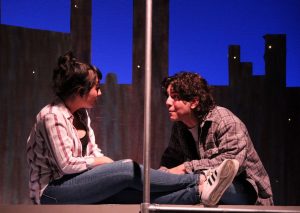 and take advantage of them in myriad ways.
and take advantage of them in myriad ways.
But there’s another reason to see Sanctuary City, and it has to do with Martyna Majok’s disregard of the normal rules of theatrical construction. The first is her disregard of temporality, or the linear progression of past, present and future.
The main characters 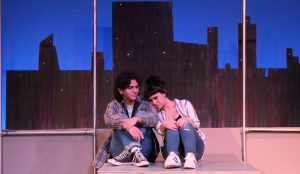 are B and G. They meet in third grade and become fast friends as G relies on B more and more to provide shelter and cover from the abuse she suffers at home at the hands of her mother’s boyfriend. Not only can’t G report the boyfriend, she has to make sure no one figures out that her regular absences from school are attributable to the physical
are B and G. They meet in third grade and become fast friends as G relies on B more and more to provide shelter and cover from the abuse she suffers at home at the hands of her mother’s boyfriend. Not only can’t G report the boyfriend, she has to make sure no one figures out that her regular absences from school are attributable to the physical  injuries mom’s boyfriend visits on her face, arms, and other body parts. If her teachers or the principal of her school realize she is a chronic victim of domestic abuse, it’s likely she and her mom will be deported back to mom’s country of origin – a place G’s never been and has no desire to go. She’s American in every way … except citizenship.
injuries mom’s boyfriend visits on her face, arms, and other body parts. If her teachers or the principal of her school realize she is a chronic victim of domestic abuse, it’s likely she and her mom will be deported back to mom’s country of origin – a place G’s never been and has no desire to go. She’s American in every way … except citizenship.
Later, B and G’s relationship changes abruptly when mom turns the  table on the boyfriend by becoming naturalized and moving out of the apartment she shares with him while he’s at work. Not only does mom get her papers, she gets G’s papers as well. Now G is a citizen, and that breaks the dynamic of her years-long relationship with B. Suddenly, she has infinite possibilities, leaving B isolated on the sidelines, looking on with a mixture of bewilderment and an envy to which he cannot give voice.
table on the boyfriend by becoming naturalized and moving out of the apartment she shares with him while he’s at work. Not only does mom get her papers, she gets G’s papers as well. Now G is a citizen, and that breaks the dynamic of her years-long relationship with B. Suddenly, she has infinite possibilities, leaving B isolated on the sidelines, looking on with a mixture of bewilderment and an envy to which he cannot give voice.
But  Majok illustrates all of this through mind-bending fast-paced scene changes that follow no particular chronological order. One minute, G is telling B about the apartment she and her mom are moving into. The next, G is crawling through B’s bedroom window to escape the latest incident of domestic abuse. Kudos to Isabella Cintron and Nicholas Salerno for the clarity and cohesion they display in a series of seemingly unconnected scenes that require instantaneous changes in blocking and dialogue
Majok illustrates all of this through mind-bending fast-paced scene changes that follow no particular chronological order. One minute, G is telling B about the apartment she and her mom are moving into. The next, G is crawling through B’s bedroom window to escape the latest incident of domestic abuse. Kudos to Isabella Cintron and Nicholas Salerno for the clarity and cohesion they display in a series of seemingly unconnected scenes that require instantaneous changes in blocking and dialogue 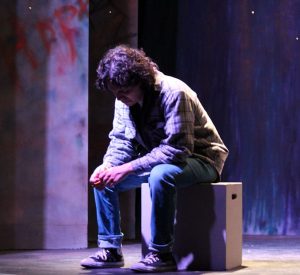 highlighted and emphasized by an imaginative use of lighting cues.
highlighted and emphasized by an imaginative use of lighting cues.
If you fashion yourself a theater-goer who is always on the hunt for something you’ve never seen before in theater, this blurring of temporality and linear chronology is rare if not entirely unprecedented. Watching these two young actors navigate the staccato changes is worth the price of admission alone.
The second rule that Majok disregards is the one that mandates that  all essential characters be introduced in the first few scenes of a book or play. In Sanctuary City, a young man named Henry does not show up until two-thirds of the way through the two-hour play. This makes sense within the construction of the play, but the long build-up also places a burden on Anthony Miller top deliver a top-flight performance. Miller doesn’t disappoint. While nobody’s waiting for Henry to arrive, he definitely
all essential characters be introduced in the first few scenes of a book or play. In Sanctuary City, a young man named Henry does not show up until two-thirds of the way through the two-hour play. This makes sense within the construction of the play, but the long build-up also places a burden on Anthony Miller top deliver a top-flight performance. Miller doesn’t disappoint. While nobody’s waiting for Henry to arrive, he definitely  pumps up the volume, breaks down the beat. [Credit to Pink.]
pumps up the volume, breaks down the beat. [Credit to Pink.]
The dialogue that passes between G, B and Henry is charged with a thousand degrees of heat. Cintron and Miller stalk and menace each other with the ferocity of ambush predators. Meanwhile, B is not just trapped between friend and lover, he’s mired in a moral dilemma reminiscent of The Lady or the Lion. If he accepts G’s offer to marry him so that he can 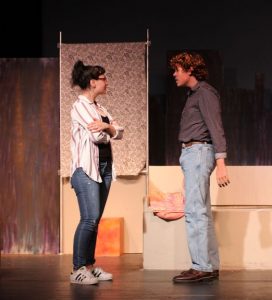 get his own papers, he has to part ways with Henry. If he chooses Henry (the play is set before Obergefell v. Hodges), he’ll be relegated to a life of 10-hour days working for employers who pay low wages and no benefits because the undocumented have no leverage in the workplace or anywhere else.
get his own papers, he has to part ways with Henry. If he chooses Henry (the play is set before Obergefell v. Hodges), he’ll be relegated to a life of 10-hour days working for employers who pay low wages and no benefits because the undocumented have no leverage in the workplace or anywhere else.
This is an intelligently and insightfully directed play that features three rising theatrical stars who are called upon to tackle difficult material and complex emotions within the context of politically-charged subject matter. Sanctuary City is theater at its best. Beyond scintillating performances, the play will disturb 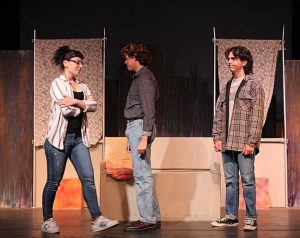 you in ways you haven’t experienced before.
you in ways you haven’t experienced before.
Go here for Sanctuary City’s remaining play dates and times.
August 19, 2023.
RELATED POSTS.
- For more on ‘Sanctuary City,’ listen here on WGCU
 ‘Sanctuary City’ asks what we’re prepared to lose for a future and those we love
‘Sanctuary City’ asks what we’re prepared to lose for a future and those we love- Spotlight on ‘Sanctuary City’ playwright Martyna Majok














 Tom Hall is both an amateur artist and aspiring novelist who writes art quest thrillers. He is in the final stages of completing his debut novel titled "Art Detective," a story that fictionalizes the discovery of the fabled billion-dollar Impressionist collection of Parisian art dealer Josse Bernheim-Jeune, thought by many to have perished during World War II when the collection's hiding place, Castle de Rastignac in southern France, was destroyed by the Wehrmacht in reprisal for attacks made by members of the Resistance operating in the area. A former tax attorney, Tom holds a bachelor's degree as well as both a juris doctorate and masters of laws in taxation from the University of Florida. Tom lives in Estero, Florida with his fiancee, Connie, and their four cats.
Tom Hall is both an amateur artist and aspiring novelist who writes art quest thrillers. He is in the final stages of completing his debut novel titled "Art Detective," a story that fictionalizes the discovery of the fabled billion-dollar Impressionist collection of Parisian art dealer Josse Bernheim-Jeune, thought by many to have perished during World War II when the collection's hiding place, Castle de Rastignac in southern France, was destroyed by the Wehrmacht in reprisal for attacks made by members of the Resistance operating in the area. A former tax attorney, Tom holds a bachelor's degree as well as both a juris doctorate and masters of laws in taxation from the University of Florida. Tom lives in Estero, Florida with his fiancee, Connie, and their four cats.